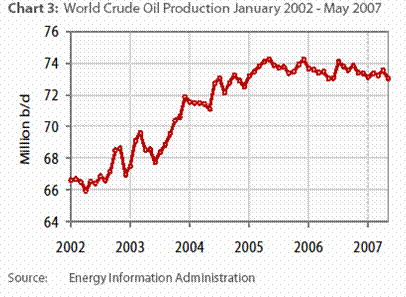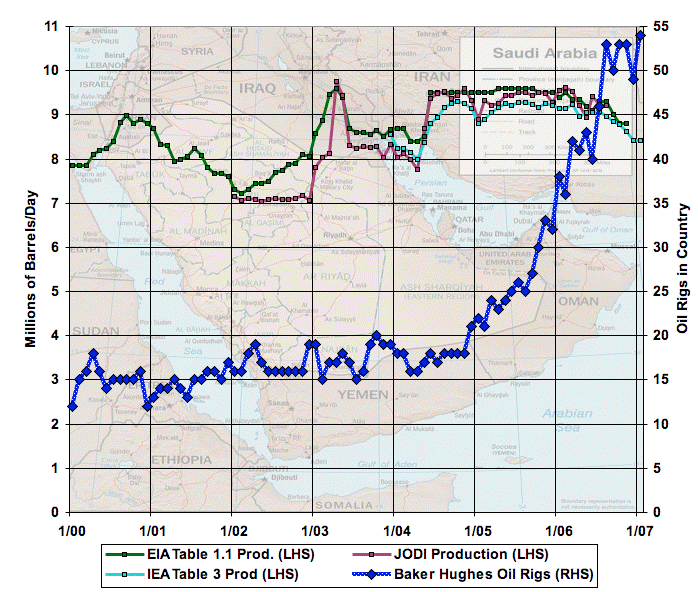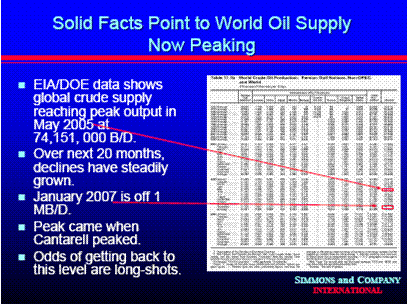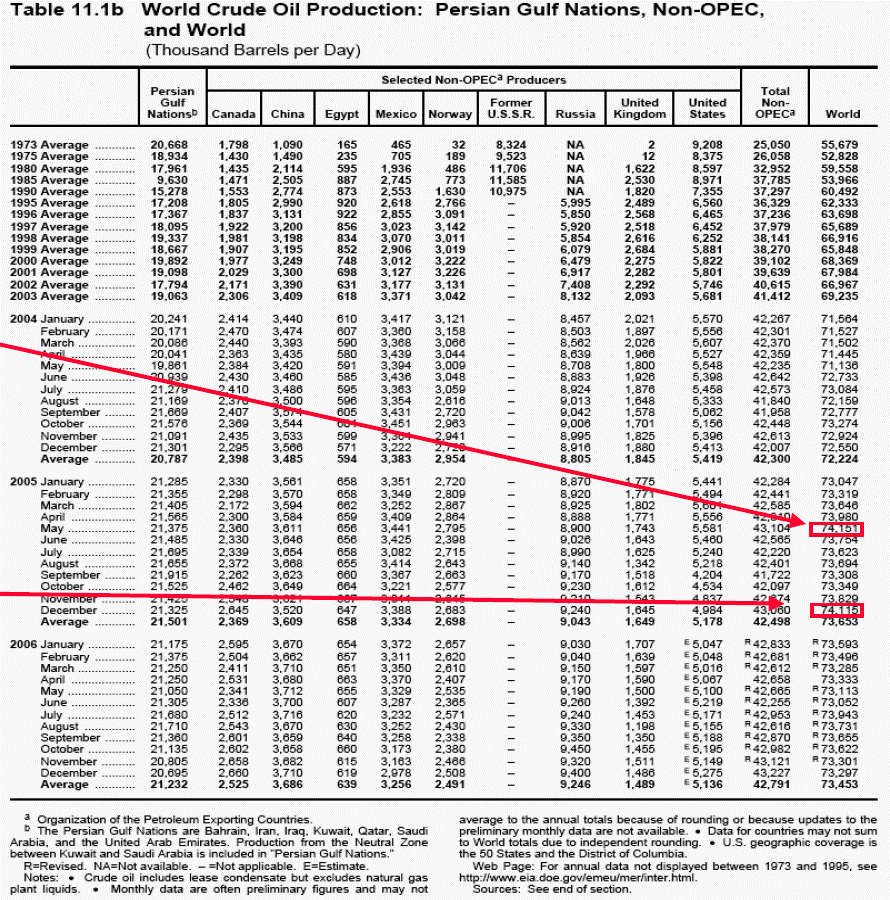「安く豊かな石油時代が終わる」こと、だが「ピーク」は「枯渇」ではない
世界の原油(石油ではない)が生産は2005年5月がピークだった(2007)
米国エネルギー省、エネルギー情報局(EIA)の月別原油生産統計による


ここで原油(crude
oil)とは、油田からの採集される流体であり、NGL(Natural
Gas Liquid)を含めない。
「石油ピーク」とは生産が需要の伸びを満たせなく、頭打ちとなると言うことである。当然需要が減少すれば、このピークは後に伸び、ピークそのものは増減しながら、長続きするかもしれない。
つまり石油ピークは動的なものであって、経済動向、省エネルギーの進展、世界のエネルギー需要などで大きく変わる。当然、価格変動による需要動態なども影響するものである。つまり石油ピークとその後の予測は、そのような意味で考えるべきである。
しかしその原点は、地球は有限、資源とは質が全てと知ることである。エコノミストはこれが理解できない、そしてぎエンジニアは技術で何でも解決できると錯覚する。その典型がIEAである。今もピークオイルを忌避する、認めない。
だがさすがに油価高騰、食料不足で、市民は何かおかしいと思いはじめたようである。地球温暖化もメディアの狂騒的キャンペーンにも疑念を持ち始めた、もっと大事なものがあるのではないかと。
08年6月19日の日経産業は、トヨタの滝本正民副社長が「20030年ごろに石油は枯渇するだろう」とのべたと報じた。後で実際にその会場にいた元トヨタ社員は「2030年ころには危ないと思う」とのべた、と教えてくれた。
枯渇という言葉を世間は簡単に使いすぎるが、いずれにせよトヨタのトップが「地球は有限」と理解している。対して初めての日本人IEA事務局長である田中氏は分かっていない。残念なことである。ちなみに氏は東大経済学部卒とのこと。(08年7月)
本気になったL.ブラウンの「石油ピーク」論、1930年代の経済恐慌の再来も!(2007−11.18)
最新のL.ブラウンの「石油ピーク」についての文です。著名なブラウンのこと、「石油ピーク」の認知に大きな影響があるでしょう。そして「PlanB3.0」を近いうちに出すとか。
関連して僭越ですが、本論の内容は拙著、「石油最終争奪戦ー世界を震撼させる「ピークオイル」の真実 2006」、「石油ピークは来たー崩壊を回避する「日本のプランB」2007」(ともに日刊工業新聞社)と同じ路線にあります、「日本のプランB」を除いて。
Earth Policy
Institute:Plan B Update Embargoed for November 15, 2007, 11:00 AM
EST
IS WORLD OIL PRODUCTION PEAKING?
http://www.earthpolicy.org/Updates/2007/Update67.htm
Lester R. Brown
Is world oil production peaking? Quite possibly. Data from the International Energy Agency (IEA) show a pronounced loss of momentum in the growth of oil production during the last few years. After climbing from 82.90 million barrels per day (mb/d) in 2004 to 84.15 mb/d in 2005, output only increased to 84.80 mb/d in 2006 and then declined to 84.62 mb/d during the first 10 months of 2007.
The combination of world production slowing down or starting to decline while demand continues to rise rapidly is putting strong upward pressure on prices. Over the past two years, oil prices have climbed from $50 to nearly $100 a barrel. If production growth continues to lag behind the increase in demand, how high will prices go?
There are many ways of assessing the oil production prospect. One is to look at the relationship between oil discoveries and production, a technique pioneered by the legendary U.S. geologist M. King Hubbert. Given the nature of oil production, Hubbert theorized that the time lag between the peaking of new discoveries and that of production was predictable. Noting that the discovery of new reserves in the United States peaked around 1930, he predicted in 1956 that U.S. oil output would peak in 1970.
He hit it right on the head.
Globally, oil discoveries peaked in the 1960s. Each year since 1984, world oil production has exceeded new oil discoveries, and by a widening gap. In 2006, the 31 billion barrels of oil extracted far exceeded the discovery of 9 billion barrels.
The aging of oil fields also tells us something about the oil prospect. The world’s 20 largest oil fields were all discovered between 1917 and 1979. (See data at http://www.earth-policy.org/Updates/2007/Update67_data.htm) Sadad al-Husseini, former senior Saudi oil official, reports that the annual output from the world’s aging fields is falling by 4 mb/d. Offsetting this decline with new discoveries or with more-advanced extraction technologies is becoming increasingly difficult.
Yet another way of assessing the oil prospect is to look separately at the leading oil-producing countries where production is falling, the ones where production is still rising, and those that appear to be on the verge of a downturn. Among the leading oil producers, output appears to have peaked and turned downward in a dozen or so and to still be rising in nine.
Among the post-peak countries are the United States, which peaked at 9.6 mb/d in 1970, dropping to 5.1 mb/d in 2006; Venezuela, where output also peaked in 1970; and the two North Sea oil producers, the United Kingdom and Norway, which peaked in 1999 and 2000.
The pre-peak countries are dominated by Russia, now the world’s leading oil producer, having eclipsed Saudi Arabia in 2006. Two other countries with substantial potential for increasing output are Canada, largely because of its tar sands, and Kazakhstan, which is developing the Kashagan oil field in the Caspian Sea, the only large find in recent decades. Other pre-peak countries include Algeria, Angola, Brazil, Nigeria, Qatar, and the United Arab Emirates.
Among the countries where production may be peaking are Saudi Arabia, Mexico, and China. The big question is Saudi Arabia. Saudi officials claim they can produce far more oil, but the giant Ghawar oil field?the world’s largest by far and the one that has supplied half of Saudi oil output for decades?is 56 years old and in its declining years. Saudi oil production data for the first eight months of 2007 show output of 8.62 mb/d, a drop of 6 percent from the 9.15 mb/d of 2006. If Saudi Arabia cannot restore growth in its oil production, then peak oil is on our doorstep.
In Mexico, the second-ranking supplier to the United States after Canada, output apparently peaked in 2004 at 3.4 mb/d. U.S. geologist Walter Youngquist notes that Cantarell, the country’s dominant oil field, is now in steep decline, and that Mexico could be an oil importer by 2015. Production in China, slightly higher than in Mexico, may also be about to peak.
A number of prominent geologists are convinced that global oil production has peaked or is about to do so. “The whole world has now been seismically searched and picked over,” says independent geologist Colin Campbell. “Geological knowledge has improved enormously in the past 30 years and it is almost inconceivable now that major fields remain to be found.”
Kenneth Deffeyes, a highly respected geologist, said in his 2005 book, Beyond Oil, “It is my opinion that the peak will occur in late 2005 or in the first few months of 2006.” Youngquist and A. M. Samsam Bakhtiari of the Iranian National Oil Company each projected that production would peak in 2007.
The Energy Watch Group in Germany, which recently analyzed oil production data country by country, also concluded that world oil production has peaked. They project it will decline by 7 percent a year, falling to 58 mb/d in 2020. Bakhtiari projects a decline in oil production to 55 mb/d in 2020, slightly lower than the German group. In stark contrast, the IEA and the U.S. Department of Energy are each projecting world oil output in 2020 at 104 mb/d.
The peaking of world oil production will be a seismic event, marking one of the great fault lines in world economic history. When oil output is no longer expanding, no country can get more oil unless another gets less. Oil-intensive industries will be hit hard. Cheap airfares will become history, for instance. The airline industry’s projected growth of 5 percent a year over the next decade will evaporate. The food industry will be severely affected by rising oil prices, since both modern agriculture and food transport are oil-intensive. The automobile industry will suffer as well when demand for cars plummets. Pressures will intensify on the three or more major auto companies that are developing plug-in hybrid cars that run largely on electricity to bring them to market quickly.
Higher oil prices have long been needed both to more accurately reflect the indirect costs of burning oil, such as climate change, and to encourage more-efficient use of a resource that is fast being depleted. While higher price are desirable, the rise should not be so abrupt that it leads to severe economic disruptions.
Some countries are much more vulnerable to an oil decline than others. For example, the United States?which has long neglected public transportation?is particularly vulnerable because 88 percent of the U.S. workforce travels to work by car.
Since options for expanding supply are limited, efforts to prevent oil prices from rising well beyond $100 per barrel in the years ahead depend on reducing demand, largely within the transportation sector. And since the United States consumes more gasoline than the next 20 countries combined, it must play a lead role in cutting oil use.
A campaign to
reduce oil use rapidly might best be launched at an emergency meeting
of the G-8, since its members dominate world oil consumption. If
governments fail to act quickly and decisively to reduce oil use, oil
prices could soar as demand outruns supply, leading to a global
recession or -- in a worst-case scenario -- a 1930s-type global
depression.
Lester R.
Brown is President of the Earth Policy Institute and author of Plan B
3.0: Mobilizing to Save Civilization(forthcoming).
2004年〜5年、サウジアラビアの原油生産量が天井を打っていたようだ、そして2006年には8%も減少した。それらの根拠を下記に、

実は2004年頃から原油生産は天井を打っていた、掘削リグを3倍に増やしても減少傾向は止められていjない。そして2006年は8%減となった。これは2004年までの従来の変動パターンと明らかに違うに思える。
世界の原油生産も伸びない。2005年の5月が最大、その後は減り2007に年は百万バーレルも下回った。下の2図が根拠とされる。これは公的データである。

[Twilight in the
Desert:2007年日本訳]の著著としても知られる、ブッシュ大統領のエネルギーアドバイザー、M.シモンズの見解で、上図の赤線の先を拡大したのが次図。これに見るとおり2005年の5月、11月が最大となっている。
これがシモンズが世界の原油生産は2005年5月ピークだったとする根拠だ。一方、K.S.デファイス(今は亡き K.ハバートの友人) は2005年11月説となる。
しかし、この違いに重大な意味はない。それは元々ピークのトップは平らな「プラトー」と見られているからである、それが変動していると見ればよい。細かく批判する必要もない。それより重大なのは、需要は旺盛にも拘らず、「原油生産が伸びない、伸ばせない」ことである。
今後「ピーク、プラトー」が変動しながらも、どの程度持つのか続くかである。シモンズは生産ピークは、メキシコの超巨大油田Cantarellのピークと共に、世界ピークが訪れたと上図で述べている。今ガワール、サウジに世界最大、地球最大の超巨大油田が減退しつつあるという、これも大きな懸念材料である。やはり世界の原油生産はピーク、プラトーなのだろうか。

今後、日本としても様々な公的、非公式のデータ、情報を注意深く観察、分析する必要がある。
最近原油価格がバーレル60ドル台で推移する、ひところ100ドルもと懸念されたが、そうはならない。これは生産量が増えているからと楽観視する向きがあるが、間違っている。発展途上国などが、もう高すぎて買えなくなった、みるべきである。しかし国際的に投機資金は流れる、もうひとつの価格変動要素である。徹底して考えることである、安易に論理を短絡してはいけない。(2007−6−4)
しか、し価格は実際に90ドル/バレルを2007年10月には越した。投機資金が石油に向った、がその説明、依然「石油ピークの脅威」は語らない。マネーゲームのためともいうが、これも間違っている。何故なら石油価格の高騰、生産量の推移などは、地球の限界という人類生存の根本に起因するからである。「石油減耗の顕在」は、早いか遅いかの違いでしかないが、人はそれを直視できないようである。それに「今主流の学問」は役に立たない、残念なことである。(2007-10-23)